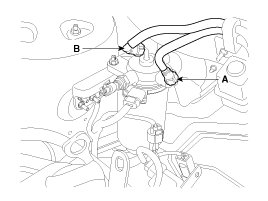Remove the fuel inlet (A) and the outlet hose (B) from the fuel filter.

If there is lack of power, excessive oil consumption or poor fuel economy, measure the compression pressure.
Warm up the engine until the coolant temperature becomes 80~95°C(176~203°F).
Remove the fuel inlet (A) and the outlet hose (B) from the fuel filter.

Crank the engine in order to exhaust fuel in the high pressure pump.
Gather residual fuel by putting the return hose into a proper vessel.
Remove the injection pipe, injector and washer. (Refer to FL group).
Measure the cylinder compression pressure.
Insert the SST(09351-27000, 09351-1M100) into the injector hole.

Cranking the engine, measure the pressure.
Use the complete charging battery for the engine to crank at the speed of 200rpm or more.
Do the above step 1)~2) again for each cylinder.
This work must be done in as short time as possible.
Compression pressure :
2157.45kPa (22kg/cm², 312.91psi) (200rpm)
Minimum pressure :
1863.25kPa (19kg/cm², 270.24psi)
Difference between each cylinder :
294.20kPa (3.0kg/cm², 42.67psi)
If, in one or more cylinders, the measured value is below the limit, fill a little engine oil into the injector holes of the cylinders, repeat the step 1)~2) and measure the compression pressure again.
If the re-measured pressure becomes higher, wear or damage of the piston ring or cylinder surface can be the cause.
If the re-measured pressure does not become higher, adherence or poor contact of the valves or inferior gasket can be the cause.
Install the injectors, washers and the injector pipes. (Refer to FL group).
Install the inlet and the outlet hoses to the fuel filter.